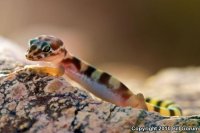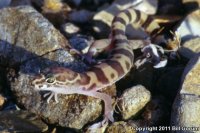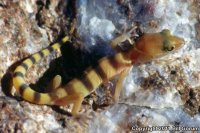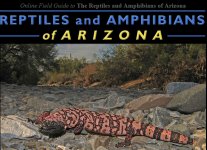| Range: |
 |
| Other Names: |
|
| Subspecies: |
Tucson Banded Gecko Coleonyx variegatus bogerti |
| Description: |
A small (up to 76 mm or 3" from snout to vent) creamy yellow lizard with reddish brown crossbands, spots, and reticulations on the body and tail. The limbs and sides are tinted with with pink. The ventral surface is plain and pale. Juveniles usually have distinct dorsal bands that break up into spots and reticulations as the animal ages. Adults in the southeastern portion of our state tend to retain the juvenile banding. A creamy yellow line loops from the corner of the eye around the back of the head to the other eye like an eyeglass strap. Behind this loop is a broad, reddish brown collar. The scales are small and granular and the skin is soft and translucent. A faint, blue-green tint is visible through the skin above each eye. The tail becomes plump when the animal is well fed. The pupils are vertically elliptical. Unlike many geckos this lizard has moveable eyelids. |
| Similar Species: |
Range is the easiest way to distinguish this gecko from the Texas Banded Gecko. This gecko has slender toes, lacks toe pads, and lacks tubercles on the body distinguishing it from the similar looking Mediterranean House Gecko. |
| Venom: |
None |
| Habitat: |
An inhabitant of our desertscrub communities. This deceptively delicate-looking lizard is capable of living in some of our states most harsh environments. It can be found in habitats ranging from extremely dry, wind blown sand dunes and creosotebush flats, through rugged rocky slopes and hillsides, to relatively barren high desert plateaus. |
| Behavior: |
This lizard is a nocturnal ground-dweller. It is often seen prowling on the surface at night and is also easily found under surface cover such as boards and trash piles. When it senses danger it twists and undulates the tail in slow, sinuous, serpentine movements. The tail is easily cast off and regenerated. When captured it will often squeak. |
| Hibernation: |
It hibernates during the cold months of winter and late fall. |
| Reproduction: |
This gecko lays up to 3 clutches of eggs per year. Eggs are laid in spring and summer and each clutch consists of 1 or 2 eggs. |
| Diet: |
Spiders and insects such as beetles, grasshoppers, larvae, and termites make up the bulk of this lizards diet. It has been observed to eat its own shed skin in captivity |















